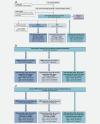Progression of HPV infection to detectable cervical lesions or clearance in adult women: Analysis of the control arm of the VIVIANE study
- PMID: 26685704
- PMCID: PMC4787275
- DOI: 10.1002/ijc.29971
Progression of HPV infection to detectable cervical lesions or clearance in adult women: Analysis of the control arm of the VIVIANE study
Abstract
The control arm of the phase III VIVIANE (Human PapillomaVIrus: Vaccine Immunogenicity ANd Efficacy; NCT00294047) study in women >25 years was studied to assess risk of progression from cervical HPV infection to detectable cervical intraepithelial neoplasia (CIN). The risk of detecting CIN associated with the same HPV type as the reference infection was analysed using Kaplan-Meier and multivariable Cox models. Infections were categorised depending upon persistence as 6-month persistent infection (6MPI) or infection of any duration. The 4-year interim analysis included 2,838 women, of whom 1,073 (37.8%) experienced 2,615 infections of any duration and 708 (24.9%) experienced 1,130 6MPIs. Infection with oncogenic HPV types significantly increased the risk of detecting CIN grade 2 or greater (CIN2+) versus non-oncogenic types. For 6MPI, the highest risk was associated with HPV-33 (hazard ratio [HR]: 31.9 [8.3-122.2, p < 0.0001]). The next highest risk was with HPV-16 (21.1 [6.3-70.0], p < 0.0001). Similar findings were seen for infections of any duration. Significant risk was also observed for HPV-18, HPV-31, and HPV-45. Concomitant HPV infection or CIN grade 1 or greater associated with a different oncogenic HPV type increased risk. Most women (79.3%) with an HPV infection at baseline cleared detectable infections of any duration, and 69.9% cleared a 6MPI. The risk of progression of HPV infection to CIN2+ in women >25 years in this study was similar to that in women 15-25 years in PATRICIA.
Keywords: CIN; HPV; VIVIANE; adult women; natural history.
© 2015 The Authors and GlaxoSmithKline. International Journal of Cancer published by John Wiley & Sons Ltd on behalf of UICC.
Figures


References
-
- Hildesheim A, Schiffman MH, Gravitt PE, et al. Persistence of type‐specific human papillomavirus infection among cytologically normal women. J Infect Dis 1994;169:235–40. - PubMed
-
- de Sanjose S, Quint WG, Alemany L, et al. Human papillomavirus genotype attribution in invasive cervical cancer: a retrospective cross‐sectional worldwide study. Lancet Oncol 2010;11:1048–56. - PubMed
-
- Appleby P, Beral V, Berrington de Gonzalez A, et al. Carcinoma of the cervix and tobacco smoking: collaborative reanalysis of individual data on 13,541 women with carcinoma of the cervix and 23,017 women without carcinoma of the cervix from 23 epidemiological studies. Int J Cancer 2006;118:1481–95. - PubMed
-
- International Collaboration of Epidemiological Studies of Cervical Cancer. Comparison of risk factors for invasive squamous cell carcinoma and adenocarcinoma of the cervix: collaborative reanalysis of individual data on 8,097 women with squamous cell carcinoma and 1,374 women with adenocarcinoma from 12 epidemiological studies. Int J Cancer 2007;120:885–91. - PubMed
Publication types
MeSH terms
Substances
Associated data
LinkOut - more resources
Full Text Sources
Other Literature Sources
Medical

